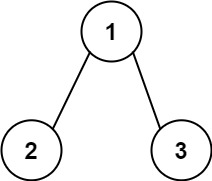1. question: 路径总和(简单)
给你二叉树的根节点 root 和一个表示目标和的整数 targetSum 。判断该树中是否存在 根节点到叶子节点 的路径,这条路径上所有节点值相加等于目标和 targetSum 。如果存在,返回 true ;否则,返回 false 。
叶子节点 是指没有子节点的节点。
来源:力扣(LeetCode)
链接:https://leetcode.cn/problems/path-sum
示例 1:

1
2
3
| 输入:root = [5,4,8,11,null,13,4,7,2,null,null,null,1], targetSum = 22
输出:true
解释:等于目标和的根节点到叶节点路径如上图所示。
|
示例 2:

1
2
3
4
5
6
| 输入:root = [1,2,3], targetSum = 5
输出:false
解释:树中存在两条根节点到叶子节点的路径:
(1 --> 2): 和为 3
(1 --> 3): 和为 4
不存在 sum = 5 的根节点到叶子节点的路径。
|
示例 3:
1
2
3
| 输入:root = [], targetSum = 0
输出:false
解释:由于树是空的,所以不存在根节点到叶子节点的路径。
|
提示:
1
2
3
| 树中节点的数目在范围 [0, 5000] 内
-1000 <= Node.val <= 1000
-1000 <= targetSum <= 1000
|
2. answers
这道题最开始的想法就是遍历所有路径,保存路径和,最后比较是否与目标值相同。遍历采用递归的方式,即以当前节点为根的二叉树,其全部路径等于,以当前节点的左右子节点为根节点的二叉树的全部路径加上左右子节点。
代码如下所示:
1
2
3
4
5
6
7
8
9
10
11
12
13
14
15
16
17
18
19
20
21
22
23
24
25
26
27
28
29
30
31
32
33
34
35
36
37
38
39
40
41
42
43
44
45
46
47
48
49
50
51
52
53
54
55
56
57
58
59
60
61
62
63
64
65
66
| public class Solution_0061 {
public static List<Integer> getSum(TreeNode tn) {
List<Integer> result = new ArrayList<>();
if(tn == null) return result;
List<Integer> leftResult = getSum(tn.left);
List<Integer> rightResult = getSum(tn.right);
if(leftResult.size() == 0 && rightResult.size() == 0)
result.add(tn.val);
else {
for(Integer i: leftResult)
result.add(i + tn.val);
for(Integer i: rightResult)
result.add(i + tn.val);
}
return result;
}
public static boolean hasPathSum(TreeNode root, int targetSum) {
List<Integer> result = getSum(root);
for(Integer i: result)
if(targetSum == i) return true;
return false;
}
public static void main(String[] args) {
System.out.println(hasPathSum(null, 3));
}
}
|
参考了题解,其实在遍历的时候,没必要开辟空间保留路径和。路径和课可以看成是节点之和,也可以看成是目标值逐个减去节点值,最后到叶子节点时,目标值为0。本质上在递归的时候,将目标值减去根节点的值,作为新的目标值即可。代码如下所示:
1
2
3
4
5
6
7
8
9
10
11
12
13
14
15
16
17
18
19
20
21
22
23
24
25
26
27
28
29
30
31
32
33
34
35
36
37
| public class Solution_0061_02 {
public static boolean hasPathSum(TreeNode root, int targetSum) {
if(root == null) return false;
if(root.left == null && root.right == null) return targetSum - root.val == 0;
Boolean left = null;
Boolean right = null;
if(root.left != null)
left = hasPathSum(root.left, targetSum - root.val);
if(root.right != null)
right = hasPathSum(root.right, targetSum - root.val);
if(left == null) return right;
if(right == null) return left;
return left || right;
}
public static void main(String[] args) {
TreeNode tn3 = new TreeNode(3);
TreeNode tn2 = new TreeNode(2);
TreeNode tn1 = new TreeNode(1, tn2, tn3);
System.out.println(hasPathSum(tn1, 0));
}
}
|
3. 备注
参考力扣(LeetCode)官网 - 全球极客挚爱的技术成长平台 (leetcode-cn.com),代码随想录 (programmercarl.com)。



